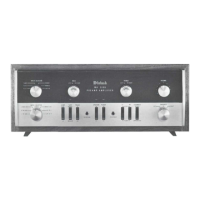Technical Description
PREAMPLIFIER SECTION
The phono and tape head preamplifier circuits in
the MA 5100 have three transistors in each channel.
The input selector switch connects the input jacks
to the first voltage gain stage of the preamplifier.
The input stage has high voltage gain and very low
noise. The next stage, an emitter follower, acts as
an impedance converter that matches the input stage
to the second voltage amplifier. The emitter follower
is direct coupled to the second voltage amplifier.
Negative feedback is used around the low level
section to reduce noise and distortion to an absolute
minimum. The negative feedback also provides pre-
cise frequency compensation for magnetic phono
cartridges and tape heads. The feedback remains in
effect through the entire audio bandwidth, even at
20 Hz where gain is the highest. This kind of careful
Mclntosh engineering assures you of lowest distor-
tion performance.
The tape head input impedance is 500,000 ohms.
High tape head impedance permits uniform high
frequency performance from typical tape transport
playback heads.
The MA 5100 is ideal for tape recording. With an
input signal from a phono cartridge of 10 millivolts,
there is 1.4 volts available at the tape output jacks.
Phono input signal overload is virtually impossible.
At 1,000 Hz the phono input will accept greater than
125 millivolts without overloading. This is more than
than 4 times the output from most phono cartridges
when playing a low distortion phonograph record.
The phono input impedance is 47,000 ohms. This
matches the impedance of magnetic cartridges.
The preamplifier output is connected by the input
selector switch to the tape output, the tape monitor
switch, the balance control, the loudness compensa-
tion switch, and the first section of the volume con-
trol. This arrangement permits recording of the pro-
gram without interruption and has the ability to moni-
tor the recorded tape.
The use of a two section volume control performs
two important functions. First, the input section of
the volume control increases the signal handling
capability of the tone control amplifier. Use of this
arrangement makes overdriving the tone control am-
plifer almost impossible. Second, the output volume
control assures maximum signal to noise ratio re-
gardless of the volume control position.
The tone control stages are made up of a three
stage amplifier. The first two transistors are emitter
followers. The first emitter follower is driven from the
output of the volume control. The second emitter
follower is direct coupled to the third stage. The third
stage is a high gain voltage amplifier.
Signals pass through the input emitter follower
and then couple to the second and third tone control
stages through the tone control network. The tone
control contours are obtained by controlling the large
negative feedback around the second and third tran-
sistors. This negative feedback is used to accurately
shape the response. The large amount of negative
feedback also makes possible low distortion from the
tone control amplifier.
The output of the tone shaping amplifier drives the
low frequency and high frequency filters and the
second section of the volume control. The filters are
designed to remove unwanted noises such as turn-
table rumble and record scratch. The filters remove
the maximum amount of objectionable material and
still have a minimum effect on the musical content
of the program material.
The output of the volume control is fed to a two
stage voltage amplifier that has very low noise
characteristics. Negative feedback is used to improve
the signal to noise ratio and assure an absolute
minimum of distortion.
The phase switch is part of the left channel circuit.
The switch selects from two sources that are of equal
amplitude but are "out of phase" to each other. In
the normal position the phase is the same in both
channels. When the phase switch is in the 180° posi-
tion the left channel is "out of phase" when com-
pared to the right. Out of phase program source ma-
terial is easily corrected with the use of this switch.
11

